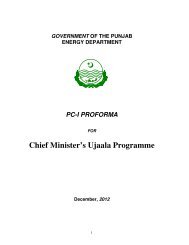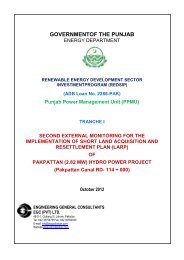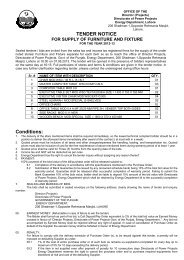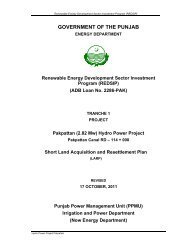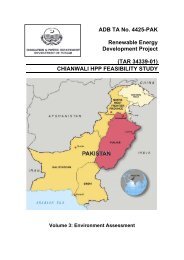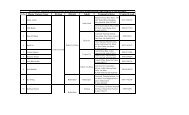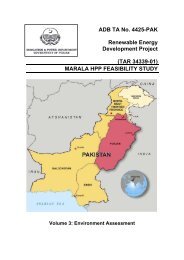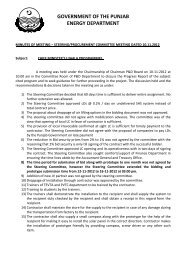Punjab Power Development Board (PPDB) - Energy Department ...
Punjab Power Development Board (PPDB) - Energy Department ...
Punjab Power Development Board (PPDB) - Energy Department ...
You also want an ePaper? Increase the reach of your titles
YUMPU automatically turns print PDFs into web optimized ePapers that Google loves.
FREQUENTLYASKED QUESTIONS<br />
1. What do you know about Pakistan<br />
Pakistan is situated between latitude North and longitude East.<br />
On the west border of the country is Iran, India is on the east, Afghanistan in the<br />
north-west, China in the north and the Arabian Sea is on the south.<br />
Pakistan has a strategically advantageous location vis-à-vis being a geographical<br />
centre of the Asian Continent. Forming a bridge between the Middle East and the<br />
Far East, Pakistan can be a hub for trade and communication. A wide<br />
transportation network complements this strategic placement. With three major<br />
international airports and 38 domestic airports, Pakistan serves more than 50<br />
international airlines. Pakistan also has Karachi, Port-Qasim and Gawadar sea<br />
ports.<br />
Pakistan has a continental type of climate, characterized by extreme variations of<br />
temperature. Very high altitudes modify the climate in the cold, snow-covered<br />
northern mountains. Temperatures on the Balochistan Plateau are somewhat<br />
higher. Along the coastal strip the climate is tempered by sea breezes. In the rest<br />
of the country temperatures rise steeply in the summer and hot winds blow across<br />
the plains during the day. The daily variation in temperature may be as much as<br />
11 degree C to 17 degree centigrade. Winters are cold with minimum mean<br />
temperature of about 4 degree centigrade in January.<br />
BASIC FACTS<br />
Official Name<br />
Capital<br />
Area<br />
Location<br />
Islamic Republic of Pakistan<br />
Islamabad<br />
796,096 sq. kilometers<br />
South Asia<br />
Geographic Co-ordinates latitude North and longitude East<br />
Climate<br />
Population<br />
Hot & humid summer, dry & cold winter<br />
170 millions<br />
Religion Islam (Muslims 97%)<br />
Languages<br />
English/Urdu<br />
Currency Rupee (US$ 1 = 94.46, 11 th October 2012)<br />
Sea ports<br />
Dry ports<br />
Karachi, Port-Qasim, Gawadar<br />
Lahore, Rawalpindi, Sialkot, Faisalabad, Peshawar<br />
and Quetta
International Airports<br />
Installed Generation Capacity<br />
No of Electricity Consumer<br />
Per Capita Electricity<br />
Consumption in Pakistan<br />
Karachi, Lahore, Islamabad, Peshawar, Sialkot and<br />
Quetta<br />
23412 MW<br />
22.42 million<br />
approx. 465kWh/annum<br />
2. What do you know about the <strong>Punjab</strong> province of Pakistan<br />
<strong>Punjab</strong> also spelled Panjab, is the most populous province of Pakistan, with<br />
approximately 55.06% of the country's total population. Forming most of the <strong>Punjab</strong><br />
region, the province is bordered by Kashmir (Azad Kashmir, Pakistan and Indian<br />
occupied Jammu & Kashmir) to the north-east, the Indian states of <strong>Punjab</strong>, Rajasthan,<br />
and Gujarat to the east, the Pakistani province of Sindh to the south, the province of<br />
Balochistan to the southwest, the province of Khyber Pakhtunkhwa to the west, and<br />
the Islamabad Capital Territory to the north. The <strong>Punjab</strong> is home to the <strong>Punjab</strong>is and<br />
various other groups. The main languages are <strong>Punjab</strong>i and Saraiki and the dialects of<br />
Mewati and Potohari. The name <strong>Punjab</strong> derives from the Persian words Panj (Five),<br />
and Āb (Water), i.e. (the) Five Waters - referring to five tributaries of the Indus River<br />
from which is also the origin of the name of "India" - these being Jhelum, Chenab,<br />
Ravi, Beas and Sutlej, that flow through the larger <strong>Punjab</strong>.<br />
<strong>Punjab</strong> is the most developed, most populous, and most prosperous province of<br />
Pakistan. Lahore has traditionally been the capital of <strong>Punjab</strong> for a thousand years; it is<br />
<strong>Punjab</strong>'s main cultural, historical, administrative and economic center. Historically, the<br />
<strong>Punjab</strong> region has been the gateway to the Indian subcontinent for people from<br />
Greece, Central Asia, Iran and Afghanistan and Vice-versa. Due to its strategic<br />
location, it has been part of various empires and civilizations throughout history,<br />
including the Indus Valley Civilization, Vedic civilization, Mauryans, Kushans,<br />
Scythians, Guptas, Greeks, Persians, Arabs, Turks, Mongols, Timurids, Mughals,<br />
Afghans, Sikhs and the British.<br />
3. What is the organizational structure of Pakistan’s <strong>Power</strong> Sector<br />
i) WAPDA (Water & <strong>Power</strong> <strong>Development</strong> Authority) <strong>Power</strong> Wing: Pursuant to<br />
WAPDA <strong>Power</strong> wing restructuring Program-1992, <strong>Power</strong> wing of WAPDA has been<br />
unbundled into following segments:<br />
A) Generation:<br />
o WAPDA Hydroelectric comprising hydro power stations (Tarbela,<br />
Mangla, Warsak, Ghazi Barotha etc.) located all over the country with<br />
installed capacity of 6443.16 MW. National Electric <strong>Power</strong> Regulatory<br />
Authority (NEPRA) grants blanket/collective Generation Tariff for all of<br />
these hydropower stations.<br />
o WAPDA owned thermal power stations have been configured into four<br />
independent generation companies commonly named as GENCO-I,<br />
GENCO-II, GENCO-III and GENCO-IV (XWAPDA GENCOs).
B) Transmission: In order to own, operate and maintain 220 kV and 500 kV Grid<br />
Stations and Transmission Lines/Network previously owned by WAPDA, a company<br />
named as National Transmission & Despatch Company Limited (NTDC) was<br />
established. NEPRA granted Transmission License to NTDC on 31 st December 2002.<br />
Under the regime set out in the License, the NTDC is entrusted to act as:<br />
a. Central <strong>Power</strong> Purchasing Agency (CPPA): As CPPA, the<br />
Company is responsible to procure power from XWAPDA GNECOs,<br />
WAPDA Hydroelectric and Independent <strong>Power</strong> Producers-IPPs (under<br />
Federal <strong>Power</strong> Generation Policies of 1994 and 2002) on behalf of<br />
Distribution Companies (XWAPDA DISCOs), for delivery through 500<br />
kV, 220 kV and 132 kV network.<br />
b. System Operator: For secure, safe and reliable operation, control<br />
and despatch; generation facilities located all over the country have<br />
been connected with the National Grid. Commonly, it is also referred<br />
to as National <strong>Power</strong> Control Center (NPCC) located at Islamabad.<br />
c. Transmission Network Operator: For operation, maintenance,<br />
planning design and expansion of the 500 kV and 220 kV<br />
transmission network.<br />
d. Central Contract Registrar and <strong>Power</strong> Exchange<br />
Administrator (CRPEA): As CRPEA, the NTDC is responsible to<br />
record and monitor contracts relating to bilateral trading system.<br />
Besides, above mentioned organization structure of NTDC, WAPDA<br />
<strong>Power</strong> Privatization Organization (WPPO) is also functioning under<br />
the administrative control of NTDC. Primarily, it deals with IPPs<br />
under Federal <strong>Power</strong> Policy-1994 and is also responsible for<br />
negotiating and finalizing the <strong>Power</strong> Purchase Agreement (of above<br />
50 MW capacities) between NTDC and Private <strong>Power</strong> Producers<br />
falling under the ambit of Federal <strong>Power</strong> Generation Policy-2002.<br />
For inference, NTDC may be referred to as a Vehicle for acquisition of power<br />
generated by generation facilities (under public and private sector) and delivery<br />
thereof to distribution companies for ultimate dissemination of electricity to<br />
different categories of end consumers.<br />
C) Distribution: WAPDA owned eight (08) distribution units (named as Area<br />
Electricity <strong>Board</strong>s) have been configured into independent Distribution Companies-<br />
XWAPDA DISCOs (duly incorporated by Securities and Exchange Commission of<br />
Pakistan). Two additional DISCOs, namely Sukkur Electric Supply Company<br />
(SEPCO) and Tribal Areas Electric Supply Company (TESCO) have also been carved<br />
out of these XWAPDA DISCOs. These DISCOs are responsible for channeling<br />
electricity from the transmission substations below 220 kV to the consumers at<br />
different distribution voltages. The end users are classified as residential,<br />
commercial, industrial, agriculture, bulk supply and street lighting etc. The<br />
distribution network is composed of lines and grid stations of 132 kV and lower<br />
voltage capacities, and each DISCO is responsible for constructing, operating, and<br />
maintaining the power distribution facilities within its dedicated geographic area.
(ii)<br />
One-Window Facilitators for Private <strong>Power</strong> Producers:<br />
o Private <strong>Power</strong> & Infrastructure <strong>Board</strong> (PPIB) at federal level is<br />
responsible for promoting, evaluating and negotiating private<br />
investments in the electric power sector all over the country. It also<br />
reviews Feasibility Studies and Implementation Time Tables.<br />
o Similar to PPIB, Alternative <strong>Energy</strong> <strong>Development</strong> <strong>Board</strong> (AEDB) plays<br />
the role of One-Window facility with respect to renewable energy<br />
based power projects in the country.<br />
o Likewise PPIB and AEDB, One-Window facilities have also been<br />
established at provincial levels like <strong>PPDB</strong> and SHYDO etc. in <strong>Punjab</strong><br />
and KPK respectively.<br />
(iii) National Electric <strong>Power</strong> Regulatory Authority (NEPRA): As evident from<br />
the name, NEPRA plays the role of regulator (established under the NEPRA<br />
Act, 1997) with respect to power sector of the country as a whole. NEPRA,<br />
interalia, has been mandated to regulate the provision of electric power<br />
services including determinations of electricity tariff, rates, charges and other<br />
terms and conditions for supply of electric power services by the generation,<br />
transmission and distribution companies.<br />
(iv)<br />
Independent <strong>Power</strong> Producers (IPPs): Generation facilities based on<br />
different fuels have been established in Pakistan under federal power<br />
generation policies issued from time to time.<br />
4. What is the total installed generation capacity in Pakistan<br />
Total installed generation capacity in the country is 23,412 MW.<br />
5. How many IPPs are functional in Pakistan<br />
At present there are 27 private power projects with an installed capacity of<br />
about 6870 MW which are in operation. In addition Kot Addu <strong>Power</strong> Company<br />
(1650MW) and KESC power plants (1946 MW) are also operating in the private<br />
sector.<br />
6. Why has private sector been inducted in power generation<br />
<strong>Power</strong> shortage had been one of the chronic problems hampering Pakistan's<br />
socio-economic growth since late 1980s; the problem had assumed such acute<br />
dimensions that power supply fell short of demand by almost 2000 MW during<br />
peak load hours. On a routine basis, this resulted in forced interruptions in the<br />
supply of electricity to consumers during peak hours resulting in load shedding.<br />
The unreliable power supply shattered the industrial progress. There was a gap<br />
between demand and supply due to the rapid increase in electricity demand<br />
(estimated to be growing at a rate of 7-8 % per annum at that time).<br />
This situation called for immediate intervention by the GOP through adoption of<br />
policy measures aimed at massive resource mobilization for investment in the<br />
power/energy sector. The enormous quantum of required investment compared<br />
with the constrained funding potential of the national exchequer, was not<br />
conducive to allocation of scarce GOP funds for power/energy. Therefore, the
GOP took a bold initiative in late 80s to induct private sector investment in the<br />
power sector.<br />
7. Why were One-Window facilities created at federal and provincial levels<br />
as dedicated institutions to handle Private <strong>Power</strong> Projects<br />
Developing power generation capacity is very capital intensive. Such amounts<br />
cannot be carved out from the annual budget of federal government. As such in<br />
late eighties the Government of Pakistan made in principle decision to seek<br />
private sector investment in power generation. Attracting investment of that big<br />
magnitude require a team of highly qualified professionals who are trained in<br />
project, financial and contract management / analysis beside being courteous<br />
and imbued in corporate culture. Long and tedious experimentations by various<br />
governmental agencies on part time basis with HUBCO (the first private sector<br />
power generation project) and other prospective Independent power Producers<br />
(IPPs) in late 1980's convinced the government to create a dedicated<br />
organization having roots in government but having a corporate look that could<br />
provide a suitable interface to private sector entrepreneurs, their consultants,<br />
lawyers, and lenders feel easy to approach, Private <strong>Power</strong> and Infrastructure<br />
<strong>Board</strong>(PPIB) was created as a dedicated one window facilitator for attracting<br />
private investments in power sector. Similarly, One-Window facilities like <strong>Punjab</strong><br />
<strong>Power</strong> <strong>Development</strong> <strong>Board</strong> (<strong>PPDB</strong>) and Sarhad Hydro <strong>Development</strong> Organization<br />
(SHDO) were also established at provincial levels.<br />
8. What is the institutional structure of power sector in the Province of<br />
<strong>Punjab</strong><br />
Government of the <strong>Punjab</strong> established <strong>Energy</strong> <strong>Department</strong> so that the province<br />
could contribute in the generation, transmission, distribution and conservation of<br />
power. <strong>Punjab</strong> <strong>Power</strong> <strong>Development</strong> <strong>Board</strong> (<strong>PPDB</strong>), working under <strong>Energy</strong><br />
<strong>Department</strong>, provides a ‘One-Window Facility’ to private investors for<br />
implementation of IPPs in the Province under <strong>Punjab</strong> <strong>Power</strong> Generation Policy,<br />
2009. <strong>Punjab</strong> <strong>Power</strong> <strong>Development</strong> <strong>Board</strong> Act, 2011 has been promulgated to<br />
provide legal cover to the activities of <strong>PPDB</strong>. To stimulate development of power<br />
projects in public and public-private partnership modes, <strong>Punjab</strong> <strong>Power</strong><br />
<strong>Development</strong> Company Limited (PPDCL), has been constituted. Moreover,<br />
<strong>Punjab</strong> Minerals Company (PMC), with the objective, interalia, of ensuring<br />
supply of coal to the coal based power projects in the province, has also been<br />
established in the Provincial Mines and Minerals <strong>Department</strong>.<br />
9. Why to invest in energy sector of <strong>Punjab</strong><br />
a) The Extremely Attractive/ investor-friendly <strong>Punjab</strong> <strong>Power</strong> Generation Policy-<br />
2009; ensuring:<br />
Risk (hydrology, wind & solar) Coverage<br />
Buy Back Guarantee<br />
Liberal Political Risk Coverage<br />
Liberal Fiscal / Financial Incentives<br />
Attractive IRR
) Facilitation for procurement / lease of land for projects provided by <strong>PPDB</strong><br />
(unheard of in other territories around the world).<br />
c) Earmarking of 5000 acres of land in Cholistan for Solar Farms<br />
d) Extremely cheap rates offered for land lease for hydro and solar power<br />
projects.<br />
e) Environmental issues dealt with by <strong>PPDB</strong> on behalf of investors.<br />
f) Attractive tariff offered.<br />
10. What is the minimum equity requirement to finance IPPs in Pakistan<br />
The minimum equity requirement for an IPP in Pakistan is 20% of the total<br />
Project Cost.<br />
11. What is the rate of return on equity investment in Pakistan<br />
During recent past, NEPRA has allowed ‘Internal Rate of Return’ based ‘Rate of<br />
Return’ on ‘Equity’ portion of Project’s Capital Cost ranging from 5% (thermal)<br />
to 18% (RE and hydro) net of with-holding tax. Federal government has also<br />
offered higher rate of return up to 20% for indigenous coal based power<br />
projects.<br />
12. What is the structure of projects’ capital cost for power projects in<br />
Pakistan<br />
Normally, NEPRA allows capital structure with Debt: Equity ratio of 80:20 and<br />
in some cases up to maximum of 70:30.<br />
13. What is meant by ‘Financial Charges’ component of projects’ capital cost<br />
for power projects in Pakistan<br />
This component comprises bank charges, commission and fees of the lender,<br />
such as arrangement fee, commitment fee and L/C commission etc. In this<br />
regard, NEPRA has imposed limit of 3% of debt portion of total project capital<br />
cost.<br />
14. What is the repayment period of debt in the tariff structure of<br />
‘Reference Generation Tariff’<br />
Customarily, for IPPs, debt is made available with re-payment period up to 10<br />
years with quarterly installments. Grace period of the loan facility is settled by<br />
keeping in view ‘Construction Period’ of the project with capitalization of<br />
interest/mark-up during said period.<br />
15. What is the ‘Financing Cost’ reckoned in the tariff structure of<br />
‘Reference Generation Tariff’<br />
Normal practice of NEPRA for our IPPs is as under:<br />
Foreign Debt<br />
Local Debt<br />
3 months LIBOR with spread up to 450 bps<br />
3 months KIBOR with spread up to 300 bps
16. Induction of IPPs has resulted in increase in consumer tariff. Is it true<br />
The Bulk <strong>Power</strong> Tariff (BPT) offered by Pakistan to the IPPs inducted under the<br />
1994 <strong>Power</strong> Policy was comparable to the IPP tariffs in other Asian countries.<br />
The increase in tariff with time is mainly due to increase in the prices of furnace<br />
oil, gas, and devaluation of the Pak Rupee. The table below depicts a 495% rise<br />
in furnace oil prices, a 208% increase in gas prices, and a 46.88% devaluation<br />
of the Pak Rupee against the US Dollar during the last eleven years.<br />
2001 2012 %age Increase<br />
RFO Price (Rs./M.ton) 11,569 68,874 495<br />
Gas Price (Rs./MMBtu) 182 560 208<br />
Devaluation of Pak Rupee vs. US Dollar 64 94 46.88<br />
17. What is the average residential and industrial tariff in Pakistan<br />
Average residential and industrial tariff in Pakistan has remained Rs. 9.84/kWh<br />
and Rs. 8/kWh during FY 2010-11.<br />
18. Is the average residential and industrial tariff in Pakistan is higher than<br />
other Asian oil-importing countries<br />
Average residential and industrial tariff in Pakistan was Rs. 5.62/kWh and Rs.<br />
7.12/kWh during FY 2009-10 vis-à-vis Korea (Rs.9.94/kWh & Rs.5.38/kWh),<br />
Japan (Rs.15.05/kWh & Rs.9.32/kWh), Singapore (Rs.12.85/kWh & Rs.<br />
9.51/kWh) Malaysia (Rs.7.46/kWh & Rs. 5.58/kWh), India (Rs.9.16/kWh % -)<br />
and Bangladesh (Rs.6.62/kWh & -).<br />
19. Are IPPs in Pakistan getting their invoices settled in time from <strong>Power</strong><br />
Purchaser (NTDC/DISCO)<br />
Currently, our power sector is beset with huge circular debt; limiting further<br />
investment in the sector. Project sponsors along with debt providers are wary of<br />
the exposure that the power sector presents because of the delayed payments<br />
and cash flow issues. However, the ‘Security Documents’ (<strong>Power</strong> Purchase<br />
Agreement and Implementation Agreement) incidental to development and<br />
operation phases of an IPP inherently provides certain level of comforts to<br />
private power producers (both equity and debt participants) in the form of<br />
guaranteed payments structured in the respective ‘Reference Generation<br />
Tariff(s)’. <strong>Power</strong> Purchaser is obliged to pay ‘Late Payment Charged’ for delayed<br />
payments at the prevalent KIBOR plus four and one-half percent (4.5%) per<br />
annum, compounded semi-annually, calculated for the actual number of Days<br />
for which the relevant amount remains unpaid on the basis of a three hundred<br />
and sixty-five (365) Day year. Under this regime, despite prevalent financial<br />
crunch emanating from higher input cost of electricity generation, IPPs are<br />
getting their invoices settled from the <strong>Power</strong> Purchaser.
20. What type of Security Documents shall be available for <strong>Punjab</strong> based<br />
On-Grid IPPs<br />
With respect to On-grid IPPs, there shall be a:<br />
o <strong>Power</strong> Purchase Agreement between IPP and <strong>Power</strong> Purchaser<br />
(NTDC/CPPA/DISCO)<br />
o Implementation Agreement between IPP and Government of<br />
Pakistan (directly or through Government of <strong>Punjab</strong>)<br />
o Fuel Supply Agreement between IPP and fuel supplier (depending<br />
upon form of fuel)<br />
o Water Use Agreement between IPP and Government of <strong>Punjab</strong>, only<br />
in case of hydropower projects<br />
o Land lease Agreement between IPP and Government of <strong>Punjab</strong>,<br />
where government owned land is under use of the Complex.<br />
21. What are the problems of setting up <strong>Power</strong> Projects in Private Sector<br />
Private sector has been facing multifarious problems in practical terms in setting<br />
up power generation plants in the country. Among others, few of them have<br />
been enumerated as follows:<br />
o Lack of Local Manufacturing Facilities and Capabilities: Presently<br />
most of the equipment and machinery required for the power<br />
generation is being imported from foreign countries. The local<br />
manufacturing capability is very limited.<br />
o High Cost of Imported Equipments: Since the power project<br />
involves multifarious type of imported heavy equipments and<br />
machinery, therefore, the cost of the same is substantially high.<br />
o Much Higher Project Capital Cost: <strong>Power</strong> projects are considered<br />
very large projects. A number of components/variables formulate the<br />
total cost of project. They inter-alia encompass project development<br />
cost, cost of land and land development, civil works, plant and<br />
equipment, spare parts, soil testing, engineering, consultancy, erection<br />
and supervision, importation charges, working capital and financial<br />
charges. Private investors face problem how to match the cost of<br />
project with means of financing.<br />
o Long Implementation and Completion Period: <strong>Power</strong> projects in<br />
private sector normally involve long period for project implementation<br />
and completion. Due to substantial completion time many costs are<br />
escalated/enhanced, ultimately total cost is also increased.<br />
o Difficulty in Finding Foreign Equity and Joint Venture Partners:<br />
Local private investors who desire to establish power generation<br />
projects are also facing difficulties in searching foreign equity or joint<br />
venture partners for the projects.<br />
o Difficulties in Arrangement of Finances: Sponsors of private power<br />
projects are facing problems in obtaining local and foreign currency
loans for their projects. The negotiations with local and foreign loan<br />
giving agencies involve much time due to which it is difficult to achieve<br />
financial close in time. On the other hand many foreign loan giving<br />
agencies require various types of guarantees. It is also difficult to<br />
obtain Supplier's Credit facilities in view of prevailing situation in the<br />
country.<br />
o Most Projects are Based on Imported Fuel: Most of the power<br />
projects are based on imported oil; this in fact is a major component of<br />
the ultimate tariff.<br />
o Lengthy and Complicated Procedures: Presently there exist a<br />
number of lengthy time and money consuming complicated procedures<br />
due to which private investors are facing problems. These include the<br />
provision of bank guarantees, finalization of many Project<br />
Agreement(s) with a number of Agencies etc.<br />
22. What type of efforts is being made by Government of the <strong>Punjab</strong> in<br />
providing financial assistance for speedy development of power projects<br />
in private sector<br />
<strong>Development</strong> of power projects requires heavy funding. Difficulty of accessing<br />
long-term international finance is proving to be a serious obstacle in raising debt<br />
for establishment of power projects. This necessitates efforts to be made by<br />
government in order to encourage private sector to come forward for<br />
investment in power generation. Consequently, in order to gain confidence of<br />
private power producers, Government of the <strong>Punjab</strong> has approved creation of<br />
following two funds:<br />
a) <strong>Punjab</strong> <strong>Power</strong> <strong>Development</strong> Fund: Fund will be dedicated for ‘Equity<br />
Participation’ with the ‘Private Sector’ Equity Partners’ towards capital cost of<br />
the power projects. Initially, Government of the <strong>Punjab</strong> will inject an amount of<br />
Rs. 6 billion in to the Fund with the hope that the Fund Manager will be able to<br />
attract an equal amount in to the Fund from international investors. The Fund<br />
will be supervised and monitored through a General Partnership (the “Fund<br />
Manager”), which will act as a Management Team as well as an Investment<br />
Committee, with investments being injected in Rupees from Government of the<br />
<strong>Punjab</strong> (Onshore Partner) and in US Dollar from international investors (Offshore<br />
Partner) through respective mutual Subscription Agreement(s). The Fund<br />
Manager will be responsible for all investment and divestment decisions and<br />
operations of investees during the investment period in accordance with the predefined<br />
terms and conditions. Besides, the Fund Manager may also be assigned<br />
the responsibility to facilitate Independent <strong>Power</strong> Producers in arrangement of<br />
Debt Component from local and international lending agencies / institutions.<br />
b) <strong>Punjab</strong> <strong>Power</strong> Guarantee Fund: This Fund is being created with the<br />
objective to give assurance by Government of the <strong>Punjab</strong> to the developers of<br />
Off-Grid power projects for payment defaults, if any, by the ultimate <strong>Power</strong><br />
Purchasers (Industrial Estate/Individual Industrial Units etc). Provision of money<br />
into this Fund will be the sole responsibility of Government of the <strong>Punjab</strong>. The<br />
afore-mentioned Fund Manager may also be assigned the responsibility to<br />
administer this Fund as well through pre-defined terms and conditions under a<br />
bilateral contract with Government of the <strong>Punjab</strong>.
23. Who determines generation tariffs for IPPs<br />
In order to promote fair competition in the electricity industry and to protect the<br />
interests of consumers, producers and sellers of electric power, the GOP has<br />
enacted the Regulation of Generation, Transmission and Distribution of Electric<br />
<strong>Power</strong> Act, 1997. Under this Act, the National Electric <strong>Power</strong> Regulatory<br />
Authority (NEPRA) has been created to introduce transparent and judicious<br />
economic regulation, based on sound commercial principles, to the power sector<br />
of Pakistan. One primary responsibility of the regulator is determination of tariff<br />
for the various generation, transmission, and distribution companies including<br />
the IPPs. NEPRA follows a standard and transparent procedure for tariff<br />
determination, which includes public hearing and views from all stakeholders.<br />
24. What are the basic principles of structuring generation tariff<br />
Tariff structure for different electricity generating companies is different.<br />
Accordingly, selection of tariff structure depends on the power sector<br />
requirements and on the capacities (which can include generation of electric<br />
energy, ensuring availability of capacity, operation under synchronous<br />
compensator mode, frequency regulation and etc.) to render necessary services<br />
by the given company for meeting those requirements.<br />
Taking into consideration the type of services to be rendered to the power<br />
system by the generating companies, as well as their metering capacities and<br />
preferences, Single-Part or Two-Part tariffs may be applied to those services.<br />
Basis for the tariff rates calculation are the classified amounts: fixed and<br />
variable expenses allocated between different services. Keeping in view, power<br />
system requirements of the country, NEPRA normally structures Reference<br />
Generation Tariff based on Two-Part regime comprising following components:<br />
a) <strong>Energy</strong> Purchase Price expressed in Rs./kWh;<br />
(Annual Revenue Requirement divided by Annual Plant Generation)<br />
b) Capacity Purchase Price expressed in Rs./kW/Month<br />
(Annual Revenue Requirement divided by Net Capacity in kW)/12<br />
a) <strong>Energy</strong> Purchase Price:<br />
<strong>Energy</strong> Purchase Price (the “EPP”) is the operating cost of a unit of electrical<br />
energy (kWh). It is payable for the energy generated and delivered to the power<br />
purchaser. This has been further bifurcated into following components:<br />
i. Fuel Cost Component: This component of tariff is meant for<br />
the cost of fuel consumed for generation of electricity.<br />
ii. Variable Operation and Maintenance Cost Component: This<br />
component caters for the cost of services of the O&M operator for<br />
routine management of the power plant. It covers operating cost of<br />
lubricants, chemicals etc. as well as maintenance cost such as<br />
replacement of parts and over-hauling of the plant as and when<br />
required.
iii. Water Use Charge (only for Hydropower Projects): This<br />
component is payable to the respective federating unit for each unit<br />
of energy generated by the plant and delivered to the power<br />
purchaser under ‘Water Use Agreement’ to be executed between IPP<br />
and the respective federating unit.<br />
b) Capacity Purchase Price:<br />
Capacity Purchase Price (the “CPP”) is a fixed monthly payment to IPP for each<br />
kilowatt (kW) of the available capacity of the plant to cater for the fixed costs of<br />
the project. It is payable provided the plant is available for dispatch to standards<br />
defined in the <strong>Power</strong> Purchase Agreement to be executed between IPP and<br />
power purchaser. The CPP has been further segregated into following<br />
components:<br />
i. Fixed Operation and Maintenance Cost Component: This<br />
component represents the fixed costs incidental to plant operation<br />
and maintenance. It covers management fee, remuneration to the<br />
personnel, rent, utilities, fee for maintaining consents,<br />
environmental monitoring, local taxes and cost of expatriate services<br />
to be engaged for O&M of the pant.<br />
ii. Insurance Cost Component: This component caters for the<br />
premium in relation to insurance policies required to be maintained<br />
for the plant as specified in the PPA and as required by the lenders.<br />
The risks to be covered through insurance include machinery<br />
breakdown, natural calamities, sabotage and consequential business<br />
interruption etc.<br />
iii.Return on Equity and Return on Equity during Construction:<br />
This component is meant to provide return on the equity invested by<br />
the project sponsors as well as redemption (only for projects on<br />
BOOT basis) thereof during tariff control period.<br />
iv.Debt Servicing: This component caters for repayment of principal<br />
and interest charges to the lenders of the project. It matches the<br />
loan repayment stream. Debt is proposed to be repaid in ten (10)<br />
years after achieving Commercial Operation Date of the plant.<br />
Project Capital Cost: Normally, capital cost of the project can be divided into<br />
following main heads:<br />
o Engineering, Procurement & Construction (EPC) Cost: This takes<br />
into account cost incurred by the project sponsors relating to<br />
preliminary work, civil works, electro-mechanical equipment including<br />
engineering & supervision.<br />
o Costs other than EPC Cost: Besides EPC Cost, project sponsor also<br />
incurs expenses relating to insurance during construction, project<br />
company costs, financing charges and interest during construction<br />
(IDC).<br />
Based on the above premise, Reference Tariff Table is established for 20 to 30<br />
years period (keeping in view technology involved). During tariff control period,
Generation Company (WAPDA Hydroelectric, XWAPDA GENCOs and IPPs) submits<br />
invoices to NTDC with respect to <strong>Energy</strong> Purchase Price and Capacity Purchase<br />
Price on monthly basis after applying already established indexation provisions on<br />
Reference Tariff (detail follows). Besides, Generation Company is also allowed to<br />
submit supplemental charges (expenses not covered in the Reference Tariff)<br />
invoices in line with the provisions of <strong>Power</strong> Purchase Agreement.<br />
Tariff Components<br />
Fuel Cost Component<br />
Variable O&M<br />
(Foreign Currency Portion)<br />
Variable O&M<br />
(Local Currency Portion)<br />
Fixed O&M<br />
(Foreign Currency Portion)<br />
Fixed O&M<br />
(Local Currency Portion)<br />
Insurance<br />
Water Use Charges (hydropower<br />
projects)<br />
Return on Equity<br />
Withholding Tax on Dividend<br />
Principal Repayment (Foreign Currency<br />
Loan)<br />
Principal Repayment (Local Currency<br />
Loan)<br />
Interest/Mark-up Payments (Foreign<br />
Currency Loan)<br />
Interest /Mark-up Payments (Local<br />
Currency Loan)<br />
Tariff Indexation & Adjustment<br />
Dependent on type of fuel used<br />
US$ to Pak Rupees & US CPI<br />
Pakistan WPI<br />
US$ to Pak Rupees & US CPI<br />
Pakistan WPI<br />
US$ to Pak Rupees, in case of foreign<br />
currency denominated insurance cost<br />
evidenced with documents<br />
Pakistan WPI<br />
US$ to Pak Rupees<br />
Nil<br />
US$ / Pak Rupees<br />
Nil<br />
Adjustments for relevant LIBOR variations.<br />
Adjustments for relevant KIBOR variations.<br />
25. What are the basic principles of structuring transmission tariff<br />
NTDC through transmission tariff (duly determined by NEPRA and notified by<br />
federal Government) submits invoices to each of the DISCOs formed consequent<br />
to the unbundling of WAPDA (termed as XWAPDA DISCOs) on account of<br />
‘Transfer Charge’ for procuring power from approved generating companies<br />
(having approved generation tariff from NEPRA) and its delivery to XWAPDA<br />
DISCOs for a billing period as under (the “Transfer Price”):<br />
Transfer Charge = Capacity Transfer Charge + <strong>Energy</strong> Transfer Charge<br />
Where:<br />
a) Capacity Transfer Charge comprises:<br />
1) Summation of the Capacity Purchase Price invoices rendered to<br />
NTDC by all the generation companies during the month divided<br />
by the sum of the maximum demand of the XWAPDA DISCOs in
kW recorded at all the delivery metering points at which power is<br />
received by the XWAPDA DISCOs.<br />
2) Use of System Charge (Fixed): the fixed charge part of the Use of<br />
System Charges in Rs. /kW/Month<br />
b) <strong>Energy</strong> Transfer Charge comprises<br />
Summation of the <strong>Energy</strong> Purchase Price invoices rendered to<br />
NTDC by all the generation companies during the month divided<br />
by summation of the Net Electrical Output (kWh) recorded at all<br />
the delivery metering points at which power is received by the<br />
XWAPDA DISCOs.<br />
As evident, primarily, the Transfer Price of NTDC being charged to XWAPDA<br />
DISCOs consists of two components; firstly impact of invoices (Capacity<br />
Purchase Price and <strong>Energy</strong> Purchase Price) received from generating facilities<br />
(duly approved by NEPRA) and secondly Use of System Charge meant for<br />
recovery of cost of service/revenue requirement of NTDC for provision of<br />
transmission services to XWAPDA DISCOs.<br />
The general revenue, which the NTDC is allowed to receive through tariff (Use of<br />
System Charge) from XWAPDA DISCOs, is called revenue requirement or cost of<br />
service. It should be sufficient to cover all costs required for reliable, safe and<br />
uninterrupted operation of the company and to receive a reasonable profit on<br />
invested capital to cater the future expansion of the transmission related<br />
facilities. As a matter of principle, revenue requirement (RR) is calculated by<br />
applying the below given formula:<br />
RR = AC + D + FC + AP<br />
Where<br />
AC– Allowed annual costs, and includes general establishment & administrative<br />
expenses<br />
D– Annual depreciation of fixed assets<br />
FC– Financial charges relating to long term loans obtained by the company<br />
AP– Allowed profit rate (assessed by the NEPRA) on Equity Base<br />
(Fixed Assets + Current Assets – outsiders’ liabilities) of NTDC<br />
The above matrix results after applying below given formula gives Use of<br />
System Charge in terms of Rs./kW/Month.<br />
(RR in Rs divided by XWAPDA DISCOs Demand in MW x 1000)/12<br />
Besides Use of System Charge (Fixed), NEPRA also determines Use of System<br />
Charge (Variable) dependent upon <strong>Energy</strong> Transfer Charge component of the<br />
Transfer Price. However, it is not applicable to XWAPDA DISCOs because the<br />
Transfer Charge is inclusive of the transmission loss charge as the same is rolled<br />
in on account of the costs divided on units delivered basis to arrive at the
Transfer Charge. Consequently, NEPRA determined Use of System Charge<br />
(Variable) is applicable only to Bulk <strong>Power</strong> Consumers (BPC).<br />
Based on the above premise, NTDC submits monthly invoices to XWAPDA<br />
DISCOs on account of Transfer Price, which becomes <strong>Power</strong> Purchase Price (PPP)<br />
for these XWAPDA DISCOs.<br />
26. What are the basic principles of structuring distribution tariff<br />
For assessing the revenue requirement (cost of service) of a XWAPDA DISCO,<br />
NEPRA carries out due diligence process based on tariff petition submitted by<br />
the Distribution Company. In order to make the Distribution Company viable,<br />
recovery of its total revenue requirement (cost of service) is required to be<br />
assured paving the way towards rehabilitation of its system and improvement of<br />
efficiency for safe and reliable provision of electric power. Revenue requirement<br />
of a XWAPDA DISCO comprises:<br />
o <strong>Power</strong> Purchase Price; as discussed under head ‘Transmission Tariff’<br />
the invoices of NTDC to XWAPDA DISCO on account of Transfer Price<br />
becomes the <strong>Power</strong> Purchase Price of the DISCO.<br />
o Distribution Margin; includes general establishment & administrative<br />
expenses, depreciation of fixed assets and Return on Rate Base.<br />
Average sale rate is calculated from the above determined revenue requirement<br />
(cost of service) by applying below given formula:<br />
Average Sale Rate = Revenue Requirement divided by Units sold by the<br />
DISCOs<br />
The above determined revenue requirement (cost of service) in terms of<br />
‘Average Sale Rate’ after application of below mentioned adjustment, is<br />
recovered from different categories of end-consumers through Tariff.<br />
o Adjustment Mechanism for <strong>Power</strong> Purchase Price:<br />
Δ PPP = + (PPP (Act) – PPP (Ref))<br />
(I – L)<br />
Where:<br />
Δ PPP<br />
PPP (Act)<br />
= Variation in <strong>Power</strong> Purchase Price including fuel<br />
price variation in terms of Rs./kWh purchased<br />
occurred in a month against the reference PPP<br />
= Actual PPP (Rs. /kWh purchased) during the<br />
month for which the adjustment is required to be<br />
made
PPP (Ref)<br />
L<br />
= Reference <strong>Power</strong> Purchase Price (PPP) in terms<br />
of Rs. /kWh<br />
= Target losses in percentage<br />
The impact of change in the PPP in the bill of individual consumer will be<br />
calculated according to the following formula:<br />
Δ PPP Adjustment =<br />
+ PPP x U (c)<br />
Where:<br />
U (c) means units consumed by the consumer during the month<br />
for which adjustment is required to be made.<br />
27. What are the main categories of electricity consumers of distribution<br />
companies<br />
End-consumers of XWAPDA DISCOs have been divided into different categories.<br />
The main categories of end-consumers are as under:<br />
A-1 General Supply Tariff – Residential<br />
A-2 General Supply Tariff – Commercial<br />
B Industrial Supply Tariff<br />
C Single Point Supply for Purchase in Bulk by a Distribution Licensee<br />
and mixed load consumers not falling in any other consumer class<br />
D Agriculture Tariff<br />
E Temporary Supply Tariff<br />
F Seasonal Industrial Supply Tariff<br />
G Public Lighting<br />
H Residential Colonies Attached to Industrial premises<br />
I Railway Traction<br />
28. What is the situation of power generation potential resources of <strong>Punjab</strong><br />
Province<br />
<strong>Punjab</strong> has limited indigenous resources for generation of electricity. It does<br />
have coal reserves that are yet to be tapped and exploited. The potential for<br />
hydro based generation exists on some barrages and canals but could only be<br />
fully harnessed if low-head technology is perfected. Biomass including<br />
agriculture waste, bagasse based co-generation at sugar mills, and municipal<br />
solid waste power projects can be installed with significant generation. Solar<br />
source is indeed practically unlimited but the cost of solar generation is still high<br />
compared to other technologies. Wind resources of the province are minimal,<br />
assessment of which for power generation is underway. The international power<br />
generation scene indicates that base load can only be met through residual<br />
furnace oil, gas, and coal fired power generation. Hydro generation has seasonal<br />
variations. Renewable power, despite the hype about environment and clean<br />
energy, still is only one percent of total power generation in the world. <strong>Punjab</strong>,<br />
therefore, has to rely on coal fired power generation with exploitation of all the<br />
hydro sites while encouraging renewable energy as it becomes more affordable<br />
and widespread.
29. What quantum of coal is required for a 50 MW coal based power<br />
project<br />
The quantity of coal required depends upon various factors like coal<br />
specifications, thermal efficiency and plant availability. A typical 50 MW power<br />
plant on <strong>Punjab</strong> coal specifications, as reported by <strong>Punjab</strong> Minerals Company<br />
(PMC), requires around 0.2 Million Tons of coal per annum (700 Tons per day).<br />
30. Where coal shall be imported from<br />
More than 95% of world seaborne thermal coal exports originate from just six<br />
countries, with the remainder being supplied from half a dozen others. The six<br />
principal coal exporting countries are Indonesia, Australia, Russia, Columbia,<br />
South Africa and USA with their 2009 coal exports as;<br />
World Top Coal Exporters (2010)<br />
Country<br />
Indonesia 200<br />
Australia 134<br />
Russia 105<br />
Columbia 69<br />
South Africa 66<br />
USA 20<br />
Canada 7<br />
Thermal Coal Exports (million<br />
Ton)<br />
31. What is the coal resource potential in the country<br />
Numerous studies have been conducted all of which have concluded that all coal<br />
reserves of Pakistan are suitable for power generation. Pakistan’s total coal<br />
reserves are 186,007 million tons. The biggest coal reserve of Thar which lies in<br />
Sindh has an estimated potential of 175,506 million tons and preliminary studies<br />
suggest that Thar is capable of generating 100,000 MW for two centuries.<br />
32. What are the difficulties in mining coal from THAR<br />
THAR coal has many technical issues like it has thick overburden (150 m), high<br />
stripping ratio (6.2 cu. m /ton), low heating value (calorific value 12.69 MJ/kg),<br />
high moisture content (50%), unavailability of cooling water, unavailability of<br />
basic infrastructure, brackish underground water, extremely hot climate, high<br />
ambient temperature (51 degrees C), serious clinkering property of coal and<br />
high mining cost.<br />
33. What efforts are being made to develop power projects based on Thar<br />
Coal<br />
The Federal Government has announced a set of incentives for coal mining and<br />
coal based power projects. Whereas the Government of Sindh (GoS) has created<br />
a high power decision making agency i.e. Thar Coal & <strong>Energy</strong> <strong>Board</strong> (TCEB)<br />
which has high level representation from both the federal and provincial<br />
governments. GoS and TCEB have allocated Rs. 27 billion for the provision of<br />
cooling water, Rs. 4.963 billion for the improvement of road network, Rs. 0.972
illion for construction of airport, while 50 acres land has been allocated for<br />
effluent disposal. Accordingly for the development of transmission line and<br />
broad-gauge rail link feasibility studies has been completed and their PC-I has<br />
been approved. Once these facilities will be completed then Thar coal projects<br />
will move smoothly.<br />
34. Instead of conventional mining why underground coal gasification<br />
projects are not being initiated<br />
Underground Coal Gasification (UCG) technology is in development stage and a<br />
pilot project at Thar block-V based on UCG is being implemented. After<br />
ascertaining commercial viability of the pilot project, large scale projects would<br />
be considered.<br />
35. How much coal is being imported into Pakistan<br />
Port Karachi currently handles around 4 Million Tons of Coal per year. An<br />
overview of Coal handled by Karachi Port in the past five years is as below;<br />
Year No of ships Coal handled/year (Tons)<br />
2006-7 69 2,702,971<br />
2007-8 90 3,556,246<br />
2008-9 85 3,387,262<br />
2009-10 93 3,658,368<br />
2010-11 98 3,895,492<br />
36. What is the prevalent Tariff for Industrial Units<br />
Industrial Units fall under the category of ‘Tariff- C Bulk Supply’ as detailed<br />
hereunder:<br />
C-3(a)<br />
For supply at 66 KV and & above and sanctioned load above 5000KW<br />
Fixed Charges Rs. 360/Kw/Month and Variable Charges Rs.11/kWh<br />
C-3 (b) For supply at 66 KV & above and sanctioned load above 5000 KW<br />
Fixed Charges Rs. 360/Kw/Month and Variable Charges Rs.<br />
14.50/kWh (Peak) Rs. 9.10/kWh (Off-Peak)<br />
37. What is the Reference Tariff for different technologies<br />
• Nishat <strong>Power</strong> (Private) Limited-Furnace Oil based 200 MW Plant<br />
Variable Charge Rs. 5.2173/kWh (Fuel Cost Component Rs. 4.7811)<br />
Capacity Charge Rs. 2.2240/kWh<br />
Total<br />
Rs. 7.4413/kWh (cents 12.1988/kWh)<br />
• Orient <strong>Power</strong> (Private) Limited-Combined Cycle based 225 MW Plant<br />
Variable Charge Rs. 2.2772/kWh (Fuel Cost Component Rs. 2.1782<br />
for Gas)<br />
Capacity Charge Rs. 1.7644/kWh<br />
Total<br />
Rs. 4.0416/kWh (cents 6.7360/kWh)
• Laraib <strong>Energy</strong> Limited-Hydro based 84 MW Plant<br />
Variable Charge Rs. 0.1749/kWh<br />
Capacity Charge Rs. 6.6614/kWh<br />
Total<br />
Rs. 6.8362/kWh (cents 8.5453/kWh)<br />
• Up-front Tariff for Wind <strong>Power</strong> Projects<br />
Rs. 17.2755/kWh ((cents 20.0878/kWh) 100% local financing<br />
Rs. 12.6100/kWh (cents 14.6628/kWh) 100% foreign financing<br />
• NEPRA (under consideration) 50 MW Local Coal based Plant<br />
Local Financing Foreign Financing<br />
Variable Charge Rs. 6.1127/kWh Rs. 6.1127/kWh<br />
Capacity Charge Rs. 6.5302/kWh Rs. 5.0037/kWh<br />
Total Rs. 12.6429/kWh Rs. 11.1168/kWh<br />
Cents 13.9392/kWh Cents12.2567/kWh<br />
Fuel Cost Component in both cases amounts to Rs.5.9286 with 27%<br />
thermal efficiency and coal price of Rs. 5,169/M.ton<br />
38. Where can one find data/information on status of power projects under<br />
development in <strong>Punjab</strong><br />
Information on the status of power projects under development in <strong>Punjab</strong> can be<br />
found from website (energy.punjab.gov.pk) of the <strong>Energy</strong> <strong>Department</strong>,<br />
Government of the <strong>Punjab</strong>.<br />
39. What is the model of hydropower project implementation in private<br />
sector<br />
Hydropower Projects in private sector are being implemented on Build- Own-<br />
Operate-Transfer (BOOT) basis and the project based on this model shall be<br />
transferred to the Government at the end of the concession period.<br />
40. What is the construction time required for development of hydropower<br />
project<br />
Due to the site specific nature and being on remote locations, construction time<br />
required for development of hydropower project is a bit longer as compared with<br />
the thermal power projects. For a medium size run of river hydropower project<br />
the development and construction time could be around 5 to 6 years whereas in<br />
case of small hydropower projects, such period could be around 3 years.<br />
41. What is the concession period for hydropower projects<br />
The concession period for BOOT based hydropower projects is up to 30 years.<br />
42. Which are the major hydropower plants in Pakistan<br />
Tarbela (3478 MW), Ghazi-Barotha (1450 MW) and Mangla (1000 MW) are the<br />
major hydropower plants in operation in Pakistan.



